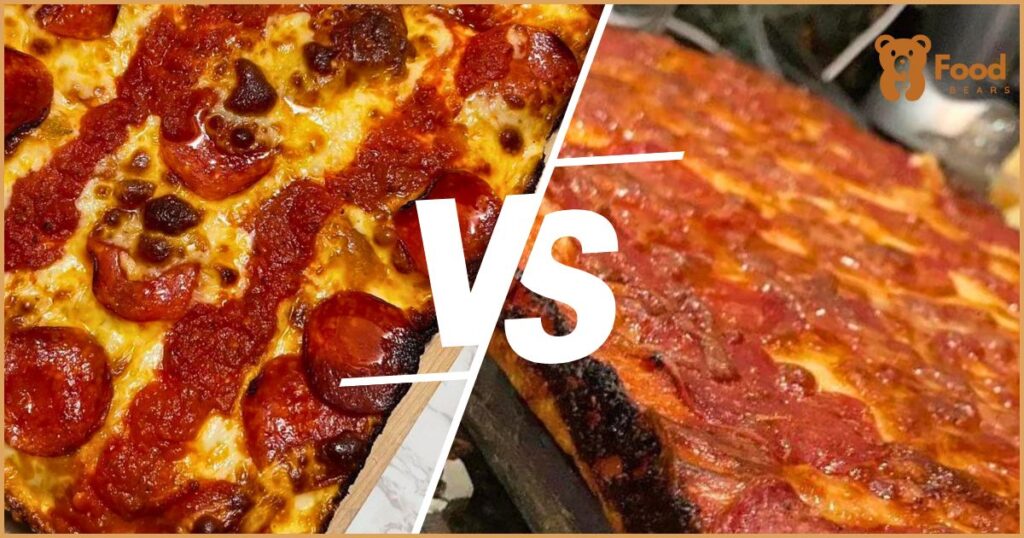Detroit pizza is square, thick, and cheesy to the edge. Sicilian pizza is also rectangular, but it's lighter, airier, and focuses on toppings.
These are two exceptional styles of pizza, each boasting a unique flair that sets them apart.
You may wonder why this matters. Well, it’s like appreciating fine art. Each pizza style has its charm and its secret recipe.
When you understand these differences, you can transform the simple act of eating pizza into an experience to savor. From the varying crust thickness to the choice and layering of toppings, it’s a regional taste and tradition masterclass.
Once you know what sets a Detroit apart from a Sicilian, every pizza night becomes a delightful exploration of tastes and textures. So, let’s enrich our pizza knowledge and add flavor to our pizza-loving lives.
Here is a comparative table on why each style could be considered the best according to different criteria.
| Aspects | Why Detroit Pizza is the Best | Why Sicilian Pizza is the Best |
|---|---|---|
| Crust | Thick, airy, crispy edges | Thick, bread-like |
| Cheese | Edge-to-edge, crispy crust | Combination of cheeses |
| Sauce | On top (“striping”) | Underneath the cheese |
| Toppings | Typically pepperoni | Variety of ingredients |
| Popularity | Rising in the US | Popular in Sicily and Italian-American communities |
| Shape | Square or rectangular | Round or rectangular |
| Softness | Light and airy | Denser and chewier |
| Cooking Method | Baked in a square steel pan | Baked in a large rectangular pan |
| Calories | Around 300-400 per slice | Around 200-300 per slice |
| Price | Varies, generally affordable | Varies, generally affordable |
What Are the Key Characteristics of Detroit and Sicilian Pizza?

While maintaining some similarities, both styles offer a unique take on the beloved dish, pizza.
Whether you prefer the caramelized cheese edges of a Detroit-style pizza or the thick, bread-like crust of a Sicilian-style pizza, each offers a delightful culinary experience.
Let’s explore the unique characteristics of both Detroit-style and Sicilian-style pizzas.
Detroit-Style Pizza
Originating in Detroit, Michigan, USA, Detroit-style pizza is characterized by its distinct rectangular shape.
Due to Detroit’s automotive history, the unique shape stems from its baking process.
It is typically cooked in a deep, square pan – reminiscent of an automobile parts tray.
- Thickness: A key feature of Detroit-style pizza is its thick, focaccia-like crust. The dough rises, often reaching a thickness of around 1.5 inches. The exterior is crispy, while the interior remains soft and airy.
- Cheese: Wisconsin brick cheese is the star of Detroit-style pizza. This cheese is spread right to the edges of the pan. During baking, it creates a signature caramelized cheese crust that’s a hit among pizza enthusiasts.
- Toppings: Toppings on a Detroit-style pizza are often layered. With pepperoni tucked under the cheese and the sauce spooned on top, lending to its other nickname, “upside-down pizza.” This arrangement helps to keep the crust light and airy during baking.
- Serving Style: Traditionally, Detroit-style pizza is cut into square or rectangular pieces and served as a hearty main dish.
Sicilian-Style Pizza
Sicilian-style pizza, or sfincione, has its roots in Sicily, Italy. This pizza style deviates from the thin, round Neapolitan pizza.
- Shape: Sicilian pizza can be rectangular or round but often square. The shape is derived from the large, rectangular baking trays in which it’s typically baked.
- Crust: The crust of a Sicilian-style pizza is akin to a thick, soft bread base, much denser than that of Detroit-style pizza. It’s comparable to focaccia and is characteristically over an inch thick.
- Cheese and Toppings: Mozzarella cheese is a classic choice for Sicilian pizza, along with a simple, flavorful tomato sauce. Toppings, including onions, anchovies, tomatoes, and herbs, are more traditional.
- Serving Style: Like Detroit-style pizza, Sicilian pizza is cut into square or rectangular slices. It’s served as a main dish, often at room temperature, and is famous as a snack or a meal in Italy.
Detroit Vs. Sicilian pizza: What’s the difference?

While Detroit-style and Sicilian-style pizzas are similar in thickness and shape, they offer distinct taste profiles, cooking methods, and textures.
1. Origin
Detroit-style pizza was born in the city of Detroit, Michigan, USA, in the 1940s. It was first made at a local bar called Buddy’s Rendezvous, now known as Buddy’s Pizza.
The creation of this pizza style was influenced by the city’s industrial background, with the square shape of the pizza inspired by the use of blue steel pans from the automotive industry.
On the other hand, Sicilian-style pizza, also known as sfincione, hails from Sicily, Italy. This style of pizza has a much longer history, dating back to the mid-19th century. It’s a traditional food in Sicily and is a staple of Sicilian cuisine.
2. Crust
Regarding the crust, Detroit-style pizza is known for its thick, airy texture, similar to focaccia bread. The dough is given ample time to rise, resulting in a light, airy interior, and a crispy exterior.
The crust is also notable for its caramelized cheese edge, achieved by spreading cheese to the edges of the pan.
Sicilian pizza, in contrast, also features a thick crust, but it’s more bread-like and less airy than Detroit-style.
The crust is soft and spongy, providing a nice contrast to the toppings. It’s a substantial crust that holds up well to various toppings.
3. Shape
The shape of these two styles of pizza is another distinguishing factor. Detroit-style pizza is typically square or rectangular, baked in a square steel pan.
This is a unique feature of Detroit-style pizza and a nod to its industrial roots.
Sicilian pizza, however, can be either round or rectangular. The most traditional shape is rectangular, but you’ll find variations depending on location.
The rectangular shape is due to the pizza being spread on a large baking sheet, allowing it to feed many people.
4. Softness
Regarding softness, Detroit-style pizza has a light, airy, and tender interior due to the high hydration dough and the long proofing time. This results in a crisp crust on the outside but soft and airy on the inside.
Sicilian pizza is denser and chewier, with a bread-like texture that’s more substantial than the Detroit style. The soft and spongy crust provides a solid base for the toppings.
5. Sauce
The sauce is another crucial difference between these two styles of pizza. In Detroit-style pizza, the sauce is typically ladled on the cheese and toppings, a technique known as “striping.” This method helps to keep the crust light and airy.
Sicilian pizza, however, usually has sauce underneath the cheese. The sauce is typically made from crushed tomatoes and spread evenly across the dough before adding cheese and other toppings.
6. Cheese: Types of cheese used
Detroit-style pizza is known for its generous use of cheese. The cheese, usually Wisconsin brick cheese, is spread to the edges of the pizza.
This results in a crispy, caramelized cheese crust that’s a signature of Detroit-style pizza. The cheese is put directly on the dough, with other toppings and sauce layered.
On the other hand, Sicilian pizza traditionally uses a combination of cheeses. The base is typically a layer of caciocavallo or another local cheese, followed by a sprinkling of pecorino.
Unlike Detroit-style pizza, Sicilian pizza doesn’t typically have cheese spread to the edges.
7. Toppings
Detroit-style pizza is typically topped with pepperoni, followed by a layer of brick cheese, and then finished with a “stripe” of tomato sauce.
Other toppings can be added as desired, but the classic Detroit-style pizza is relatively simple with its toppings.
Sicilian pizza is traditionally topped with a simple tomato sauce, onions, anchovies, and herbs. However, it can also be topped with other ingredients, such as olives, tomatoes, mushrooms, ham, and more.
The toppings on Sicilian pizza are typically more varied and plentiful than Detroit-style pizza.
8. Cooking method
Detroit-style pizza is baked in a square steel pan, a nod to the city’s automotive industry roots. The high-sided pan gives the pizza a thick, airy crust with crisp edges.
Sicilian pizza is also baked in a pan, typically a large rectangular. The dough rises in the pan, creating a thick, bread-like crust. The pizza is baked until the golden crust, and the toppings are cooked.
9. Popularity
Both Detroit-style and Sicilian-style pizzas have their fan bases. Detroit-style pizza has been gaining popularity in the United States, with several Detroit-style pizzerias opening up in various cities nationwide. However, it’s still not as widely known or available as other pizza styles.
Sicilian pizza is famous in Sicily and other parts of Italy, and it’s also well-known in areas with large Italian-American populations, such as New York City.
However, like Detroit-style pizza, it’s less ubiquitous than Neapolitan or New York-style pizza.
10. Price
The price of Detroit-style and Sicilian-style pizzas can vary widely depending on where you’re buying them.
You can expect to pay more for these pizza styles than a basic cheese pizza due to the extra time and ingredients required.
However, they’re both typically less expensive than gourmet pizzas topped with high-end ingredients.
| Pizza Style | Average Price in the USA | Average Price in Canada | Average Price in the UK |
|---|---|---|---|
| Detroit | $13.99 for a 14-inch round pizza | $9.99 for a Detroit Style Pizza | £13.95 for a large pizza |
| Sicilian | Up to $19.99 for a Sicilian Crust Pizza, $22.19 for a 16-slice pizza | Price data not available | £19.95 for a mega 12-slice pizza |
11. Taste
The taste of Detroit-style pizza is characterized by its rich, cheesy flavor, thanks to the generous use of Wisconsin brick cheese. The caramelized cheese crust adds a delightful crunch and a unique taste. Typically spooned on top after baking, the sauce adds a tangy contrast to the rich cheese.
On the other hand, Sicilian pizza has a more balanced, less rich flavor. The bread-like crust provides a robust and satisfying base, while the toppings, which traditionally include onions, anchovies, tomatoes, and herbs, add a variety of flavors. A simple tomato sauce and a combination of cheeses add depth to the overall taste.
12. Health
Both Detroit-style and Sicilian-style pizzas can be part of a balanced diet if enjoyed in moderation.
However, due to the generous use of cheese and the thick crust, Detroit-style pizza can be pretty high in calories and fat. A Detroit-style pizza can contain 300-400 calories, depending on the toppings.
Sicilian pizza, while also high in calories due to its thick crust and cheese, can be slightly lower in fat and calories if it’s topped with vegetables and lean proteins. A slice of Sicilian pizza typically contains around 200-300 calories.
| Health Aspects | Detroit Pizza | Sicilian Pizza |
|---|---|---|
| Calories | Around 300-400 per slice | Around 200-300 per slice |
| Fat Content | Higher due to the generous use of cheese | Lower, varies with toppings |
| Fiber | Moderate, from the crust and vegetable toppings | Higher, due to thick bread-like crust and potential for vegetable toppings |
| Protein | Moderate to high, from cheese and meat toppings | Moderate, from cheese and potential for meat toppings |
| Sodium | It can be high, especially with pepperoni and cheese | It can be high, especially with cheese and certain toppings like anchovies |
Please note that these are general estimates, and the actual nutritional content can vary based on the specific ingredients used and the size of the slice. Both styles of pizza can be part of a balanced diet if enjoyed in moderation.
13. Serving Style
Detroit-style pizza is typically served in square slices, in line with its square shape. This makes it easy to serve and eat and is perfect for sharing.
Sicilian pizza is traditionally cut into large, rectangular slices. This makes it an excellent option for feeding a crowd, as one Sicilian pizza can yield many slices.
How to Make Perfect Detroit Pizza?

Known for its thick, airy crust, crispy cheese-edged pan, and unconventional layering of toppings, the Detroit pizza style has been winning hearts nationwide.
So, if you’re ready to venture into pizza-making, follow this simple step-by-step guide to create your perfect Detroit-style pizza.
| Preparation Time | Baking Time | Total Time | Servings |
| 45 minutes | 15-18 minutes | Around 5 hours | 12 |
Ingredients You’ll Need
For the Deep-Dish Dough:
- 2 3/4 cups (330g) of high-protein bread flour
- 2 teaspoons of active dry yeast
- 1 tablespoon of sugar
- 1 teaspoon (6g) of salt
- 1 cup (237g) of warm water
- Extra virgin olive oil for the pan and dough-greasing
For the Hearty Sauce:
- 2 tablespoons of extra virgin olive oil
- 3 cloves of garlic, minced
- 1 teaspoon of dried oregano
- One 28-ounce can of fire-roasted crushed tomatoes
- 1 tablespoon of balsamic vinegar (optional)
For the Classic Toppings:
- 6 to 8 ounces of sliced pepperoni
- 7 ounces of Wisconsin brick cheese, shredded
- 7 ounces of smoked provolone cheese, shredded
Your Pizza-Making Journey
- Knead that Dough: In a large bowl, mix the bread flour, yeast, sugar, and salt. Gradually add warm water, mixing until a soft dough forms. Knead the dough on a floured surface for about 5 minutes until smooth.
- Rise to the Occasion: Cover your dough in a greased bowl and let it rise until it doubles. This process should take about 2 to 3 hours.
- Set the Stage: While your dough is rising, preheat your oven to 475°F. Grab a Detroit-style pizza pan or a 9″ x 13″ pan and generously oil it with olive oil.
- Shape it Up: Once the dough has risen, stretch it gently to fit the corners of the pan. If the dough resists, let it relax for about 15 minutes and then continue the process until it covers the entire pan base.
- Sauce it Up: Heat olive oil over medium heat in a saucepan. Add minced garlic and dried oregano, stirring until fragrant. Pour in crushed tomatoes, simmer, and reduce until you have a thick, hearty sauce. For a touch of sweetness, stir in optional balsamic vinegar.
- Let’s Layer: Add a layer of pepperoni to the dough. Mix the shredded cheese and spread them evenly over the pepperoni. Ensure the cheese reaches the pan’s edges. Lastly, add dollops of the rich tomato sauce on top.
- Bake to Perfection: Bake the pizza on the middle rack of the oven for 15 to 18 minutes, or until the cheese is melted and the crust edges are a deep, golden brown.
- Serve Up: Allow the pizza to cool for 10 minutes, then remove it from the pan. Slice your pizza into squares (true to Detroit style) and serve a taste of the Motor City right in your kitchen.
How to Make Perfect Sicilian Pizza?

Sicilian pizza is known for its thick, bread-like crust and abundance of toppings. Often called silicone, Sicilian-style pizza is ideal for those who prefer a slice with more substance.
Let’s take you on a culinary journey to create an impeccable Sicilian-style pizza right at home.
| Preparation Time | Baking Time | Total Time | Servings |
| 45 minutes | 15-20 minutes | Around 4-5 hours | 8-12 |
Ingredients You’ll Need
For the Hearty Crust:
- 3 cups (360g) of all-purpose flour
- 1 1/4 cups (295ml) of warm water
- 1 packet (or 2 1/4 teaspoons) of active dry yeast
- 1 teaspoon of sugar
- 2 tablespoons of olive oil
- 1 teaspoon of salt
For the Robust Sauce:
- 1 tablespoon of olive oil
- 3 cloves of garlic, finely minced
- 1 can (28 ounces) of crushed tomatoes
- 1 teaspoon of dried basil
- 1 teaspoon of dried oregano
- Salt and pepper to taste
For the Topping Symphony:
- 2 cups of shredded mozzarella cheese
- 1/2 cup of finely grated Parmesan cheese
- Additional toppings like sliced bell peppers, onions, olives, or cooked Italian sausage (optional)
Your Sicilian Pizza Adventure
- Craft the Dough: Start by dissolving yeast and sugar in warm water. Let it sit for about 5 minutes until it becomes frothy. In a large mixing bowl, combine flour and salt. Make a well in the center, then pour the yeast mixture and olive oil. Mix until a dough forms.
- Knead to Perfection: Turn the dough onto a floured surface and knead for 5-7 minutes until smooth and elastic.
- Let it Rise: Place your kneaded dough in a greased bowl, cover it with a clean cloth, and let it rise in a warm area until it doubles. This process should take about 2 to 3 hours.
- Sauce it Up: Heat olive oil over medium heat in a saucepan. Add minced garlic, stirring until aromatic. Pour in crushed tomatoes, basil, oregano, and season with salt and pepper. Simmer and reduce until you have a rich, thick sauce.
- Preheat and Prepare: Preheat your oven to 475°F. Oil a large rectangular baking tray (12×17 inches) and stretch the dough until it covers the entire base. If the dough springs back, rest for 10 minutes before continuing.
- Layer it Up: Spread your homemade tomato sauce evenly across the dough, leaving a small border for the crust. Sprinkle generously with shredded mozzarella and Parmesan, and add any other toppings you desire.
- Bake Your Masterpiece: Bake the pizza for 15-20 minutes until the crust is golden and the cheese is bubbly and slightly browned.
- Slice and Serve: Let your pizza cool for a few minutes before slicing it into squares, as is traditional with Sicilian pizza. Serve warm, and enjoy a bite of Sicilian goodness.
FAQs
Q. What are the characteristics of Detroit Pizza?
Detroit pizza is a thick, chewy, soft crust with a crispy bottom and edges. That’s your first taste of a Detroit pizza. Its crust resembles a beautiful hybrid of traditional pizza and focaccia bread. It’s baked in a rectangular steel pan, which gives it its unique shape.
The layering of ingredients sets it apart. Instead of sauce, then cheese, then toppings, it switches things up. First comes the cheese – specifically Wisconsin brick cheese spread to the edges.
Then come the toppings, and the tomato sauce is finally spooned on top. This sequence creates a delightful caramelized cheese crust around the edges. This unique combination of texture, taste, and flip-reversed layering makes Detroit pizza oh-so-special.
Q. What are the characteristics of Sicilian pizza?
Sicilian pizza has a thick, square, rectangular, and airy crust. The crust is similar to bread’s thickness and texture, making it a hearty choice. The cheese and toppings are added, and then, as a final flourish, the tomato sauce is spooned on top.
It’s typically topped with a hearty dose of oregano and often features various toppings, from anchovies to onions to tomatoes. Sicilian pizza is the kind of pizza that fills you up with just a couple of slices.
Q. What’s the difference between Sicilian pizza and regular pizza?
Regular pizza, often referred to as Neapolitan, is what most people think of when they hear “pizza.” It’s round with a thin, soft, and chewy crust, simple toppings under the cheese, and a cooked tomato sauce.
Sicilian pizza is a whole different ball game. It’s got a thick, bread-like crust, it’s square or rectangular, and the sauce generally goes on top of the cheese and toppings.
It’s like the cool cousin of the regular pizza – a little different, but still incredibly delicious.
Q. What is Detroit vs. Chicago vs. Sicilian pizza?
Detroit-style pizza is your square-shaped buddy with a thick, crispy, and almost focaccia-like crust. Cheese goes down first, then toppings and the sauce is drizzled over the top.
Chicago-style pizza, on the other hand, is the deep-dish champion. Its crust is thick buttery, usually filled with cheese and toppings, followed by an uncooked tomato sauce.
Sicilian pizza from Italy boasts a rectangular shape with a thick crust but is generally lighter and airier than its Detroit counterpart. Its cheese and toppings are under the sauce, and it often features a variety of toppings.
Wrap It Up
We’ve sliced right through the heart of the Detroit vs. Sicilian pizza debate, examining every topping, every chunk of cheese, sauce, and every square inch of crust.
Sure, pizza often gets a bad rap, and you’ve probably heard about the ’15 Reasons Why Pizza Is Bad for Health‘. It’s true: Pizza can be high in calories, sodium, and unhealthy fats. Too much of it can contribute to obesity and other health problems.
But hold on. We won’t let that spoil our pizza party. The great thing about pizza is that it’s adaptable.
By making healthier choices in ingredients, you can create a pizza that’s as good for our bodies as it is for our taste buds.
And whether it’s Detroit or Sicilian style, there’s always a way to make it a little bit healthier.

Ella Foster, co-founder of FoodBears.com, is a skilled writer whose love for cooking fuels her creative work. Her passion for experimenting in the kitchen brings authentic flavor and culinary inspiration to every piece she crafts for the platform.
